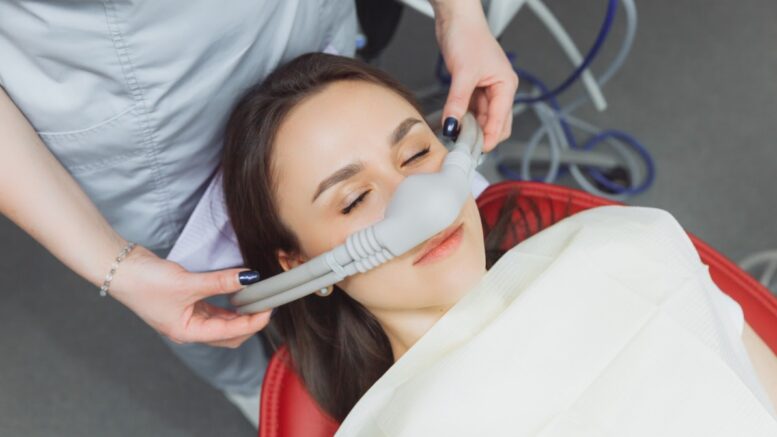Patients can calm down and feel more at ease during dental procedures with the help of dental sedation. It may involve invasive procedures like extractions or root canals and routine check-ups. Utilizing sedatives during dental procedures allows patients to unwind and experience less anxiety and discomfort.
There are several reasons why dental sedation may be used. When visiting the dentist, some patients may experience intense anxiety or fear, making it challenging to receive the required care. Others might have a low pain threshold or trouble staying still for long periods. Patients undergoing lengthy or invasive procedures, such as wisdom tooth removal or multiple fillings, can also benefit from dental sedation.
If you’re considering dental sedation, you should visit sedation dentistry clinic services to find an experienced provider and ask about available options. Moreover, read on to dig deeper into dental sedation, particularly its types, benefits, and precautions.
Types Of Dental Sedation
Several different types of dental sedation are available, each with unique benefits. It’s important to discuss the various options with your dentist to determine which type of sedation is right for you. To learn more about it, see the details below.
Inhalation Sedation
Inhalation sedation, also known as nitrous oxide sedation, involves inhaling a gas through a mask placed over the nose. The gas helps to relax patients and reduce anxiety and discomfort during a procedure. Nitrous oxide is often used for shorter treatment, and since it’s a mild form of sedation, patients can drive themselves home after the procedure.
Oral Sedation
Oral sedation is a type of sedation where the patient takes a pill or liquid medication before the procedure. The drug used for oral sedation is usually a sedative that causes the patient to feel sleepy and relaxed. Patients who receive oral sedation may still be able to communicate with their dentist but may not remember much of the procedure afterward.
IV Sedation
IV sedation is a type of sedation where the medication is administered through a vein. IV sedation is considered a moderate form of sedation and allows the patient to remain conscious but relaxed. IV sedation is used for more complex procedures that may take longer.
General Anesthesia
General anesthesia is a type of sedation where the patient is put to sleep during the procedure. General anesthesia is used for more invasive procedures, and patients can’t communicate with their dentist. An anesthesia provider administers general anesthesia and requires the patient to be monitored throughout the dental treatment.

Benefits Of Dental Sedation
Dental sedation can provide many benefits for patients who experience anxiety or discomfort during dental procedures. These benefits include:
Anxiety relief:
For patients who experience anxiety or fear when it comes to dental procedures, sedation can provide a sense of calm and relaxation. It can make the experience less stressful and more manageable, allowing patients to receive the care they need without feeling overwhelmed.
Comfort during procedures:
Sedation can also make procedures more comfortable for patients. It can be particularly beneficial for patients with low pain tolerance or who are sensitive to specific dental tools or instruments.
Multiple procedures in one visit:
With sedation, patients may tolerate multiple dental procedures during a single visit, which can save time and reduce the number of appointments needed.
Reduced pain and discomfort:
Sedation can also help to reduce pain and discomfort during procedures. It can make the experience more manageable for patients and reduce the need for pain medication after the treatment is completed.
Improved healing:
Sedation can also help to improve recovery after a procedure. The body is less stressed and more relaxed during the treatment, which can speed up healing.
Precautions For Dental Sedation
Precautions are essential when it comes to dental sedation. Before the procedure, it’s crucial to have a pre-procedure preparation. It may include avoiding food and drink before the procedure, arranging transportation and accompaniment after the dental treatment, and informing your dentist about any medical conditions or medication you’re currently taking.
Additionally, you must notify your dentist if you have a history of allergies or reactions to anesthesia or sedatives. To ensure the best possible outcome, stopping smoking or using tobacco products before the procedure is recommended.
During the procedure, your dentist will monitor you to ensure your safety. After the treatment, it’s vital to follow any post-procedure care instructions provided by the dentist. It may include taking prescribed medications, avoiding certain foods or drinks, and following a specific oral hygiene routine. Following these instructions is essential to ensure a successful recovery and minimize the risk of complications.
Conclusion
Dental sedation can be a valuable tool for improving the overall dental experience for patients. However, it’s essential to choose the right type of sedation and to have it administered by a qualified and experienced dental professional. If you have questions or concerns about dental sedation, don’t hesitate to ask your dentist or visit a reputable sedation dentistry clinic for more information.
